
Water technology company Xylem (NYSE:XYL) reported Q2 CY2025 results beating Wall Street’s revenue expectations, with sales up 6.1% year on year to $2.30 billion. The company’s full-year revenue guidance of $8.95 billion at the midpoint came in 2% above analysts’ estimates. Its non-GAAP profit of $1.26 per share was 9.9% above analysts’ consensus estimates.
Is now the time to buy Xylem? Find out by accessing our full research report, it’s free.
Xylem (XYL) Q2 CY2025 Highlights:
- Revenue: $2.30 billion vs analyst estimates of $2.21 billion (6.1% year-on-year growth, 4.2% beat)
- Adjusted EPS: $1.26 vs analyst estimates of $1.15 (9.9% beat)
- Adjusted EBITDA: $502 million vs analyst estimates of $469.5 million (21.8% margin, 6.9% beat)
- The company lifted its revenue guidance for the full year to $8.95 billion at the midpoint from $8.75 billion, a 2.3% increase
- Management raised its full-year Adjusted EPS guidance to $4.78 at the midpoint, a 3.8% increase
- Operating Margin: 13.3%, up from 11.7% in the same quarter last year
- Free Cash Flow Margin: 9%, similar to the same quarter last year
- Organic Revenue rose 6% year on year (9% in the same quarter last year)
- Market Capitalization: $31.78 billion
“Our team delivered another strong quarter, exceeding expectations with robust organic revenue growth across all segments, a record-high adjusted EBITDA margin, and double-digit EPS growth,” said Matthew Pine, Xylem’s president and CEO.
Company Overview
Formed through a spinoff, Xylem (NYSE:XYL) manufactures and services engineered products across a wide variety of applications primarily in the water sector.
Revenue Growth
Examining a company’s long-term performance can provide clues about its quality. Any business can experience short-term success, but top-performing ones enjoy sustained growth for years. Thankfully, Xylem’s 12% annualized revenue growth over the last five years was excellent. Its growth beat the average industrials company and shows its offerings resonate with customers, a helpful starting point for our analysis.
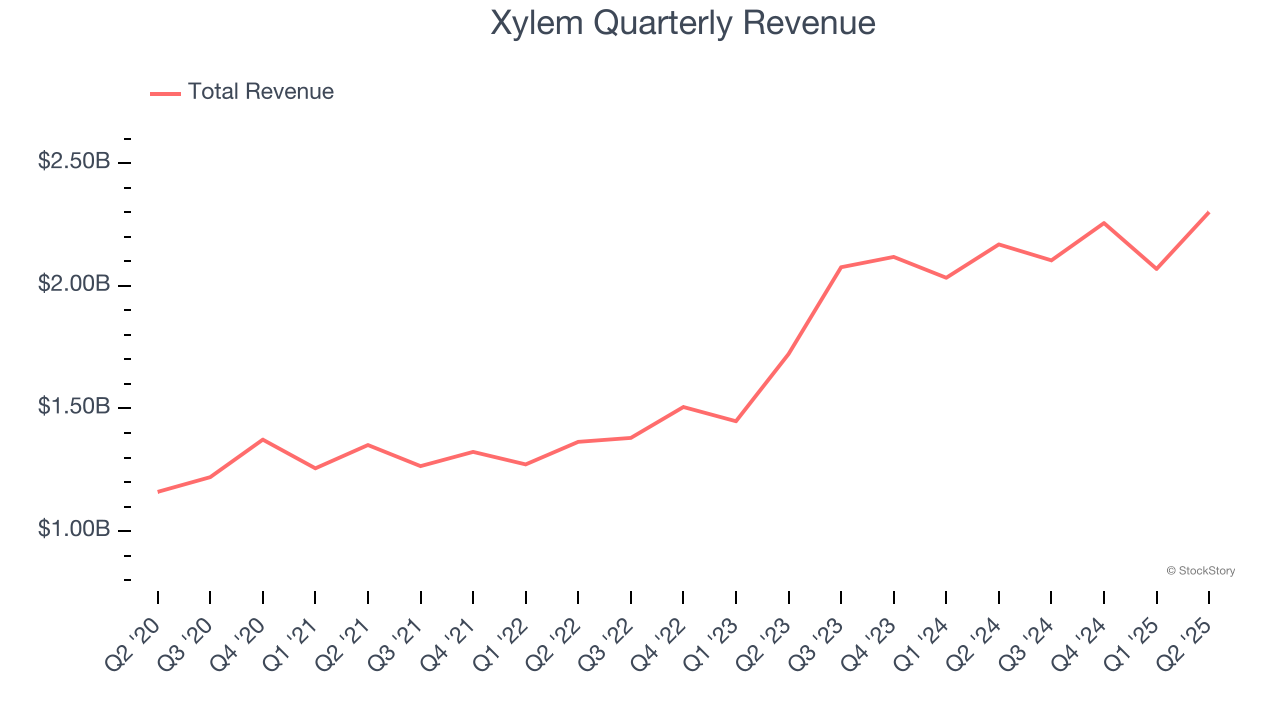
Long-term growth is the most important, but within industrials, a half-decade historical view may miss new industry trends or demand cycles. Xylem’s annualized revenue growth of 20.1% over the last two years is above its five-year trend, suggesting its demand was strong and recently accelerated. 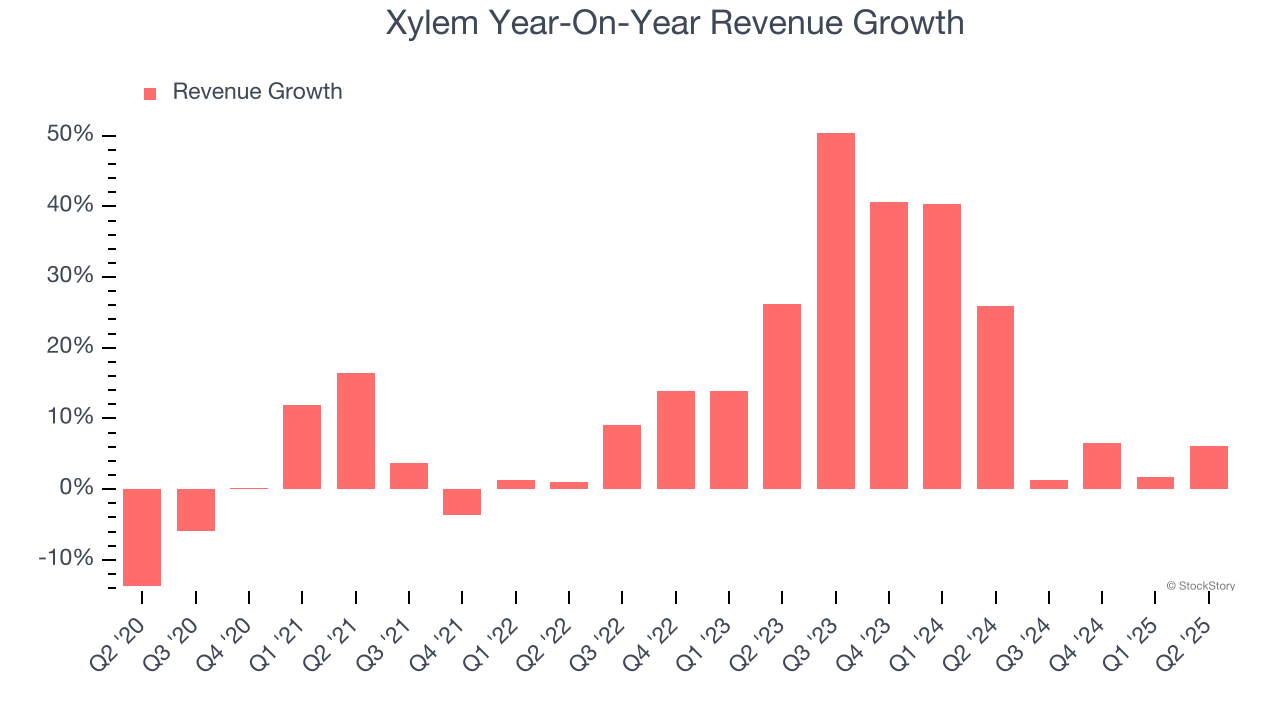
We can better understand the company’s sales dynamics by analyzing its organic revenue, which strips out one-time events like acquisitions and currency fluctuations that don’t accurately reflect its fundamentals. Over the last two years, Xylem’s organic revenue averaged 6.5% year-on-year growth. Because this number is lower than its two-year revenue growth, we can see that some mixture of acquisitions and foreign exchange rates boosted its headline results. 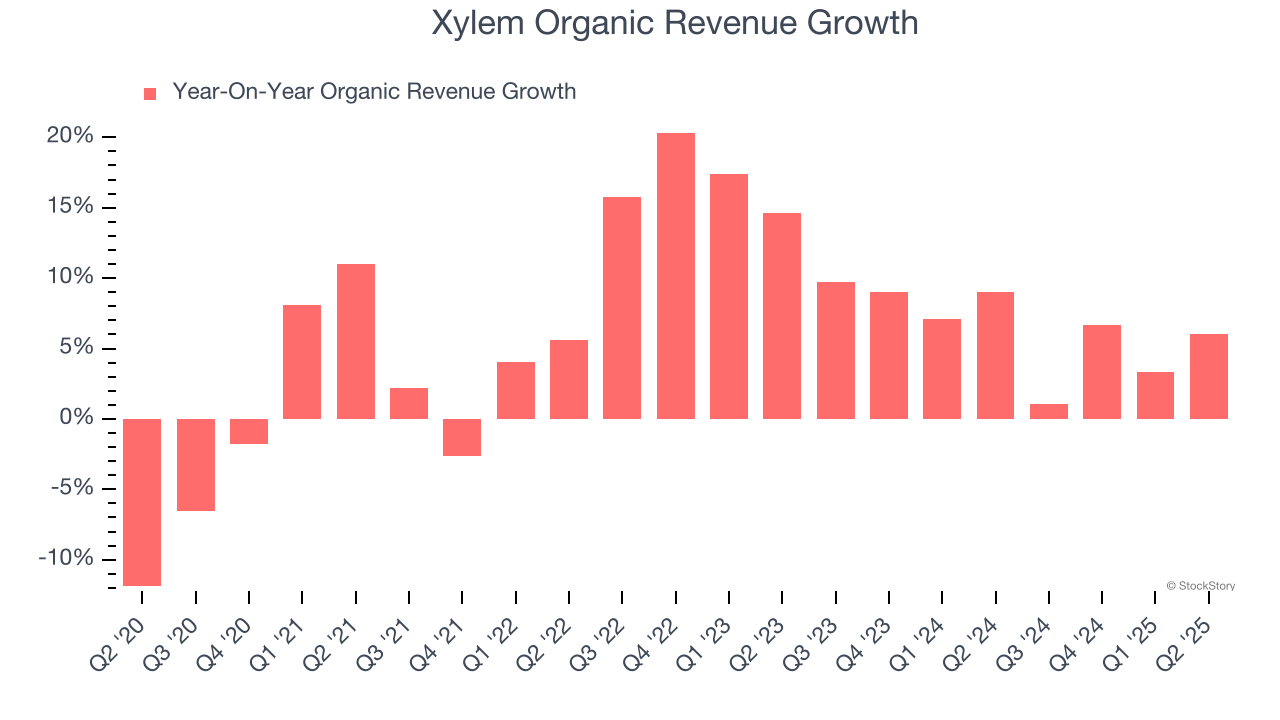
This quarter, Xylem reported year-on-year revenue growth of 6.1%, and its $2.30 billion of revenue exceeded Wall Street’s estimates by 4.2%.
Looking ahead, sell-side analysts expect revenue to grow 2.6% over the next 12 months, a deceleration versus the last two years. This projection is underwhelming and implies its products and services will face some demand challenges. At least the company is tracking well in other measures of financial health.
Software is eating the world and there is virtually no industry left that has been untouched by it. That drives increasing demand for tools helping software developers do their jobs, whether it be monitoring critical cloud infrastructure, integrating audio and video functionality, or ensuring smooth content streaming. Click here to access a free report on our 3 favorite stocks to play this generational megatrend.
Operating Margin
Operating margin is an important measure of profitability as it shows the portion of revenue left after accounting for all core expenses – everything from the cost of goods sold to advertising and wages. It’s also useful for comparing profitability across companies with different levels of debt and tax rates because it excludes interest and taxes.
Xylem has managed its cost base well over the last five years. It demonstrated solid profitability for an industrials business, producing an average operating margin of 10.9%. This result isn’t surprising as its high gross margin gives it a favorable starting point.
Looking at the trend in its profitability, Xylem’s operating margin rose by 1.9 percentage points over the last five years, as its sales growth gave it operating leverage.
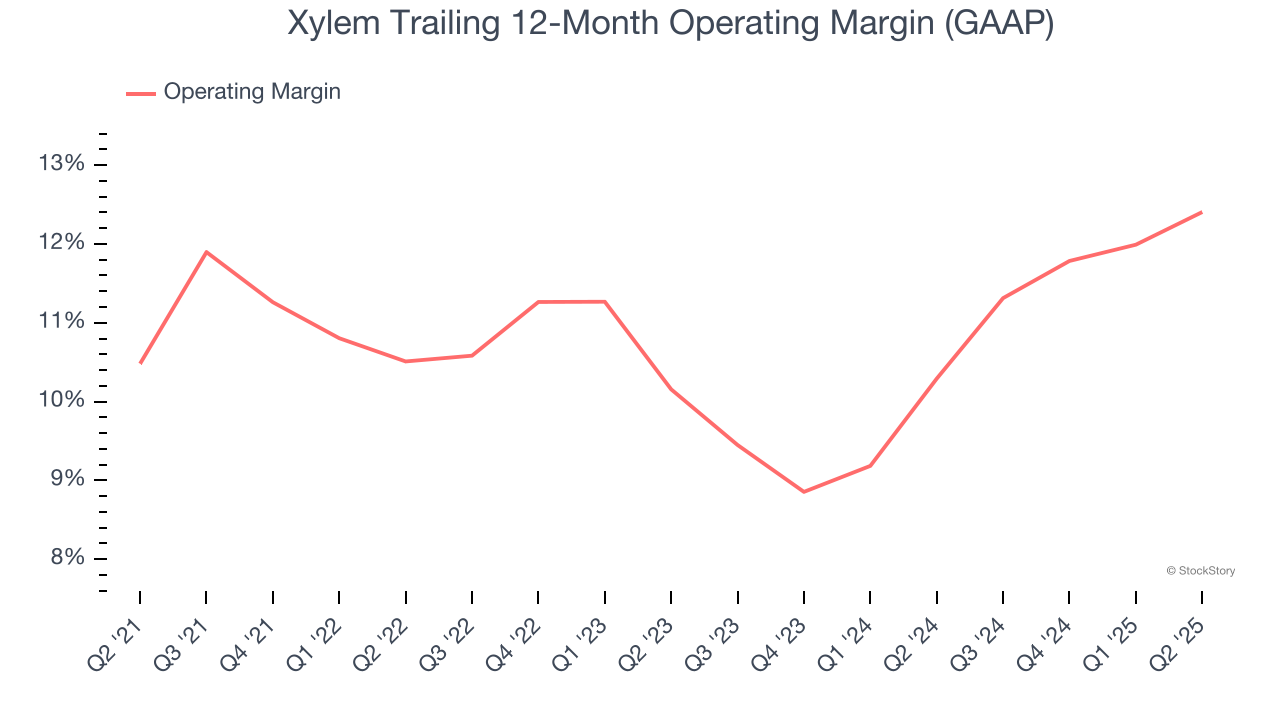
This quarter, Xylem generated an operating margin profit margin of 13.3%, up 1.6 percentage points year on year. The increase was encouraging, and because its operating margin rose more than its gross margin, we can infer it was more efficient with expenses such as marketing, R&D, and administrative overhead.
Earnings Per Share
We track the long-term change in earnings per share (EPS) for the same reason as long-term revenue growth. Compared to revenue, however, EPS highlights whether a company’s growth is profitable.
Xylem’s EPS grew at a remarkable 14.4% compounded annual growth rate over the last five years, higher than its 12% annualized revenue growth. This tells us the company became more profitable on a per-share basis as it expanded.
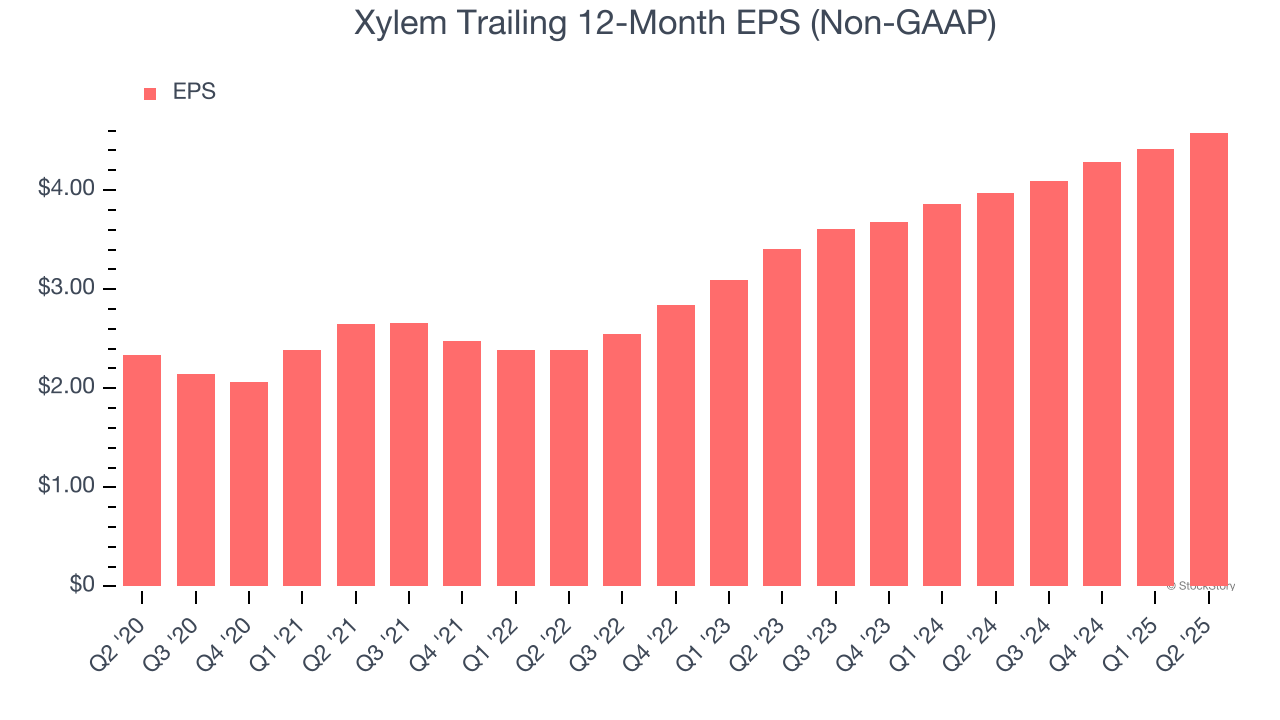
We can take a deeper look into Xylem’s earnings quality to better understand the drivers of its performance. As we mentioned earlier, Xylem’s operating margin expanded by 1.9 percentage points over the last five years. This was the most relevant factor (aside from the revenue impact) behind its higher earnings; interest expenses and taxes can also affect EPS but don’t tell us as much about a company’s fundamentals.
Like with revenue, we analyze EPS over a more recent period because it can provide insight into an emerging theme or development for the business.
For Xylem, its two-year annual EPS growth of 15.9% was higher than its five-year trend. We love it when earnings growth accelerates, especially when it accelerates off an already high base.
In Q2, Xylem reported adjusted EPS at $1.26, up from $1.09 in the same quarter last year. This print beat analysts’ estimates by 9.9%. Over the next 12 months, Wall Street expects Xylem’s full-year EPS of $4.58 to grow 5.7%.
Key Takeaways from Xylem’s Q2 Results
We were impressed by how significantly Xylem blew past analysts’ organic revenue, EPS, and EBITDA expectations this quarter. We were also excited it lifted its full-year revenue and EPS guidance. Zooming out, we think this was a good print with some key areas of upside. The stock traded up 3.3% to $135 immediately after reporting.
Sure, Xylem had a solid quarter, but if we look at the bigger picture, is this stock a buy? When making that decision, it’s important to consider its valuation, business qualities, as well as what has happened in the latest quarter. We cover that in our actionable full research report which you can read here, it’s free.
